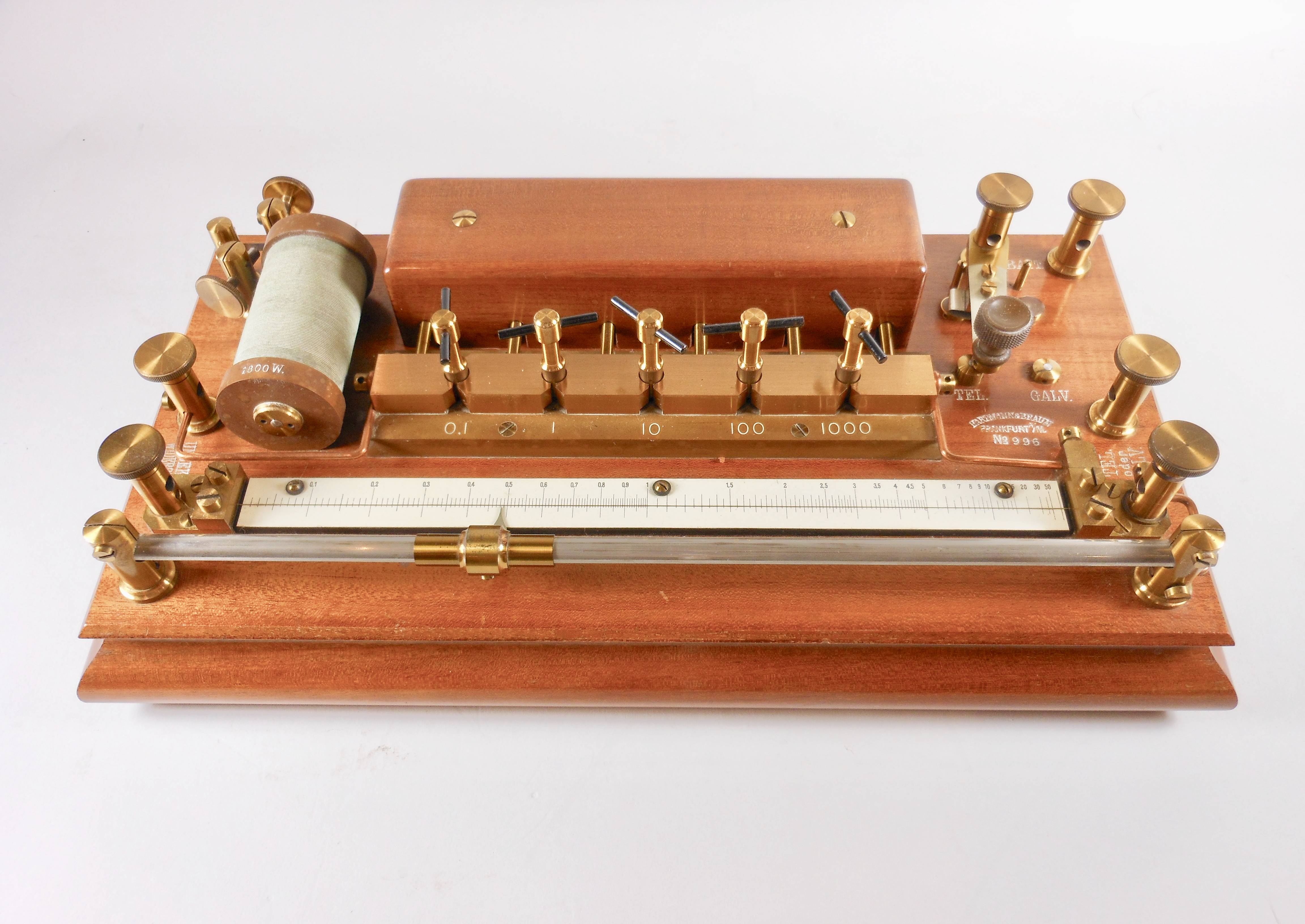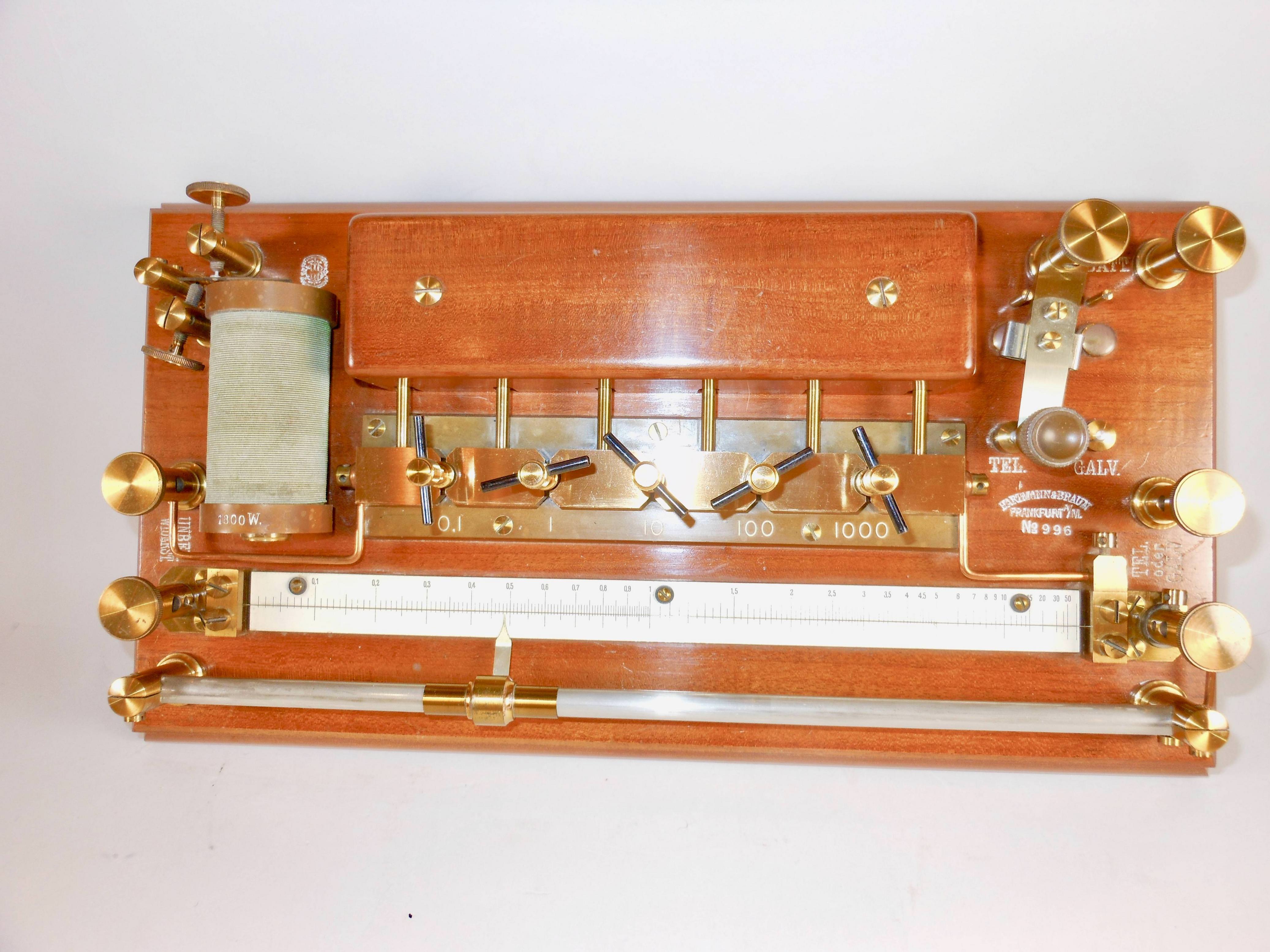Kohlrausch universal rheometer c. 1910 Hartmann & Braun, Frankfurt Germany Wood, brass, insulated wire, steel, aluminum, plastic, bakelite, copper wire Combination instrument used to read small resistances 13” long x 9” wide x 4” high This instrument is a combination bridge, rheostat and induction coil. It was used to measure the resistance of soil and fluid conductors as well as wires, batteries and other conductors by means of either a galvanometer or a telephone. It reads the resistance in ohms and includes an induction coil. There are five resistance plugs marked 0.1, 1, 10, 100 and 1000. There is also a slide wire and slider with a white scale that for the first 1/2 of the scale reads from 0.1 to 1 and then for the second half the numbers increase rapidly going from 1 to 50. The polished mahogany base is 13” x 7”. It is signed with the maker’s name, city and serial number, “Hartmann & Braun - Frankfurt a/M. No 996.” It is a very aesthetically appealing instrument in excellent condition. All of its lacquered brass is original and it shows little or no use. _____ The prefix “rheo”, which refers to resistance, was introduced by English scientist/inventor of many scientific breakthroughs of the Victorian era, Charles Wheatstone in 1837. Rheo is from the Greek root meaning "to flow”. An induction coil or "spark coil" (formerly known as a “Ruhmkorff coil” after Heinrich Ruhmkorff), is an electrical transformer used to produce high-voltage pulses from a low-voltage direct current (DC) supply. It was invented by Nicholas Callan but was named “Ruhmkorff” as he was the one who commercialized it and patented the first one in 1851. Friedrich Wilhelm Georg Kohlrausch (1840-1910) was a German physicist and a professor of physics for universities in Germany, Switzerland and France. He investigated the properties of electrolytes and contributed to the understanding of their behavior. He wrote a book about guidelines to practical physics which was published in 1870 as the first book of its type in Germany. It was issued in many editions, translated into English and was considered the standard work on physical laboratory methods and measurements. He also wrote a book on the electrical resistance of mercury in 1888 and contributed to many scientific journals. To this day, one of his textbooks, “Praktische Physik” (Practical Physics), is standard reading for physicists and engineers in Germany. He also developed improved measurement techniques in electricity and magnetism. Hartmann & Braun was founded in Germany in 1879. By the turn of the century it was the leading producer and supplier of electrical measuring devices for physical quantities like pressure and temperature. It employed approximately 1,000 people in a new plant in 1941. Its parent plant was partly destroyed in an air raid in 1944 during World War II and 165 workers lost their lives. The new plant was largely unaffected except that it was temporarily confiscated by the American Army at the end of the war. In 1999, Hartmann & Braun integrated into the ABB group. Wilhelm Eugen Hartmann, who was self-taught, started out with an optical apparatus, mechanical and geodetic instrument shop in 1879. Wunibald Braun joined him as a business partner in 1882 and the company was soon producing electrical measuring devices for physical quantities (a “physical quantity” is any physical property that can be quantified, i.e., can be measured using numbers). Around 1901, the company went from producing one-off measuring instruments to industrial series production of switchboard devices. They also produced recorders with which up to six measured values could be recorded simultaneously. In 1879, Hartmann set up his own business where he produced measuring instruments for his precision electrical measurements for Prof. Kohlrausch. From this cooperation emerged the spring galvanometer and the mirror galvanometer with telescope reading. In 1881 he became the German representative of the American Bell Telephone Company (later part of AT & T ). In 1884 he founded Hartmann & Braun with businessman Wunibald Braun for the construction of telephone systems, sales of heavy current machines and the production of electrical measuring instruments. The Eugen Hartmann Prize was named after Hartmann. Wunibald Braun was a German industrialist and co-founder with Hartmann of Hartmann & Braun. One of Wunibald’s younger brothers was Ferdinand Bruan, who was a Nobel prizewinner and one of the great scientists of the late 19th and early 20th centuries. Ferdinand told Wunibald about Hartmann’s workshop and its great opportunities in electrical engineering. At the time, there was still a lack of a simple built-in ammeter. Thanks to Kohlrausch, the spring galvanometer was built, for which Hartmann had made the preliminary tests with the current balance. Wunibald recommended they move their “instrument construction company” to Frankfurt and the most important electrical engineering company in Frankfurt was born. They focused on the development of electrical instruments. Wunibald died in 1912. Hartmann followed him three years later. Some of the sons of both founders had joined the factory and its administration over the years. Upon Hartmann’s death, they took over the leadership of the company.

